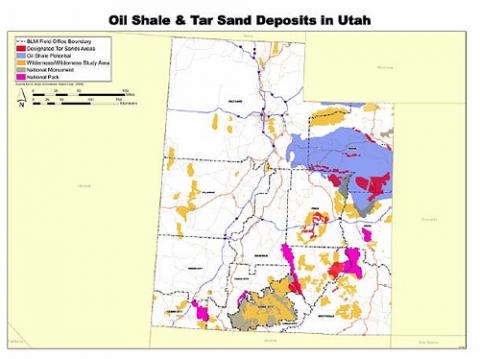Back in January 2008 the Traveler warned about a movement in the U.S. Bureau of Land Management to allow tar sands development in Utah.
Well, it seems that project could soon be sprouting near Arches National Park and Dinosaur National Monument.
According to a post by writer RL Miller on the Daily Kos the other day, back in September a Canadian company, Earth Energy Resources, received an oil sands production permit from the state of Utah. "This is the first oil sands production permit to be granted in the United States and represents a very significant milestone for the Company and the US domestic oil sands and oil shale industry," the company announced in November.
Well, that permit is being appealed by both the Sierra Club and the Southern Utah Wilderness Alliance. This Wednesday the groups will call on the the Utah Department of Natural Resources to block that development. The meeting runs from 8 a.m. to 6 p.m. at 1594 West North Temple in Salt Lake City.
What's the big deal? Developing tar sands is a dirty, and thirsty, business. Even the BLM acknowledged in its 1,400-page Oil Shale and Tar Sands Draft Programmatic Environmental Impact Statement that these energy projects "completely displace all other uses of the land."
According to the report, which the BLM was required to produce by the Energy Policy Act of 2005, full implementation of the plan could lead to air in the region being "contaminated with carbon monoxide, nitrogen oxide, sulfur dioxide and other pollutants, while air close to the site could be contaminated with benzene, toluene and formaldehyde. More than 100,000 acres of wilderness-quality land could be industrialized, construction of reservoirs would alter natural streamflow patterns, hydrocarbons and herbicides could cause 'chronic or acute toxicity' in wildlife and habitat for 20 threatened or endangered species could be lost."
That plan also called for the BLM to make more than 400,000 acres of public land available for development, including land located adjacent to or near Glen Canyon National Recreation Area, Canyonlands National Park, Dinosaur, and Natural Bridges National Monument. More than 25,000 acres are adjacent to Canyonlands and Glen Canyon in the “Tar Sand Triangle.”
It will be interesting to see whether the groups' appeal is successful.


 Support Essential Coverage of Essential Places
Support Essential Coverage of Essential Places







Comments
While I generally do not support the idea that the areas around a park are also protected from development. This is an land use that is just plain bad.
Normally on this site you will see a article about very valuable piece of land that the National Park Service is NOT responsible for, that falls out side of the park being developed and people are all upset about it. I am of the belief that if it was that valuable then why did no government agency have the vision to purchase it and protect it. Cheap park development is to leave the property alone, then try to fight it in court when walmart moves in. Apparently lawyers are cheaper than land. It is almost an intimidation tactic to try to force the land owner to either leave the land undeveloped or to donate (or sell at a ridiculous price) to the NPS. (stop yelling at me, I know its an unpopular opinion, but that is why lines on a map are drawn crisp, and not with fuzzy line.)
This issue of sand oil.. this is just strip mining for oil. I have no issue with developing natural resources, but when that development will significantly alter the natural landscape well beyond the boarders of the approved land, then it should be stopped, and opposed with every legal method.
Are these 2 positions a double standard??? Absolutely not. I believe in the importance of the line on the map. No one has the right to have the activities of their land bleed over onto someone elses. Whether that is the NPS destroying the value of a private person's property by opposing its development or if it is a oil mining operation that will send chemicals and smell into the air, and change water flow patterns, and introduce toxins to the wildlife population, well beyond the property lines into the park. My position is not hypocritical...
Unfortunately, SUWA and the Sierra Club settled their lawsuit and the hearing for Wednesday is off. There are still other options for stopping this project though, including getting the EPA to require an air permit.
Do we need petroleum so badly that we are willing to degrade our scenic lands and scarce water resources? To me, conservation is the better alternative. At a minimum, the tar sands production companies should be made to compensate the taxpayers for the full cost of extraction and rehabilitation.
"Having to squeeze the last drop of utility out of the land has the same desperate finality as having to chop up the furniture to keep warm." - Aldo Leopold
Is the hearing really off for Wednesday? If so, where can we find details on the settlement of the lawsuit?
I've been informed from a reliable source that the hearing is off. Lawsuit settlements are not always public, and I don't have them. I've also heard that the land is on state-owned property, so the BLM is not involved. However, some people near the project think that the EPA should be involved and that Grand County (Moab) should also be given a voice. This issue will develop over the next few months.